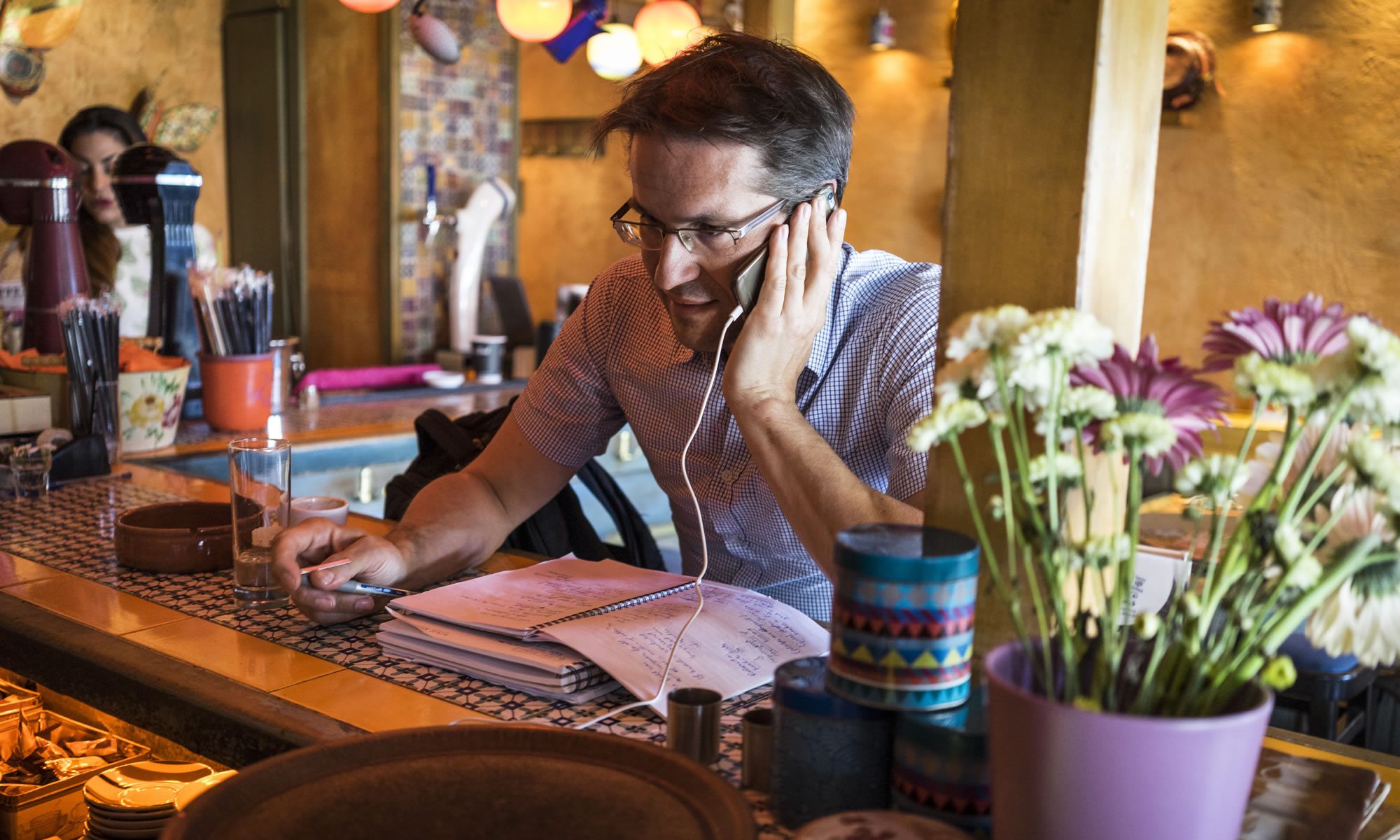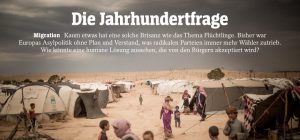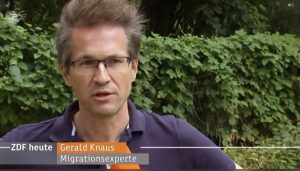Der Spiegel Title Story (August 2018)
ZDF Heute – 11 August 2018
In recent weeks, we sent a number of letters to European policy makers with concrete suggestions how Spain, Germany and others might move ahead in addressing the current Mediterranean migration and rescue crisis. Here is a summary of some of the concrete things that we suggested in these letters (and in a few meetings):
There needs to be a strong joint commitment to sea rescues.It is unacceptable to let people drown who might be saved with more effort. In June 2018 – the first month with Italian Interior Minister Matteo Salvini –more people drowned in the central Mediterranean than in any June in the past decade!
While it is crucial to send more rescue boats, this is not in itself enough to reduce deaths. The deadliest six-month period in the Mediterranean was actually the period May-October 2014, when Italy was fully engaged in its ambitious rescue mission (Mare Nostrum): more than 3,000 people died on the way to Italy. (The deadliest full year was 2016, the year when most rescues took place).
Spain, France, Germany and others should provide more rescue boats outside the Libyan territorial waters. The objective must be to ensure that nobody drowns; while arrivals are reduced without push-backs.There are three possible ways to achieve this:
discourage people who have no need of protection from coming, by sending a clear message that those who do not need international protection will be returned to their countries of origin quickly, following a fair but fast asylum procedure.
work with transit states that stop boats leaving (as Spain did with Senegal in 2006 and with Morocco for a longer period; as Italy and the EU have done, much more problematically, with the Libyan coast guard since early 2017; or as the EU and some members have done working with Niger to stop smugglers taking people through the Sahara).
send back people who are rescued to North Africa, or to some “processing platforms”, as Matteo Salvini, Viktor Orban and Sebastian Kurz have long advocated as “Australian solution”, modelled on Nauru; an option the last EU council requested should be studied. This is both highly problematic legally and completely impractical. When some European leaders present such platforms as their proposal what they really appear to want is a thin cover for push-backs to Africa.
The first option is by far the best. It represents a real humane alternative to Salvini’s current approach. It combines control and empathy, sea rescues and returns.Can a strategy based on this first option be implemented? Yes, it can.It would require three concrete measures:
1. European RICs – registration and identification centres, what the European Council called “controlled centres” (the term hotspot, discredited by the awful conditions on the Greek island, should be dropped): i.e. humane, decent accommodation centres, set up in European Mediterranean countries of arrival, jointly funded, perhaps even jointly run, as concrete expressions of solidarity. The opposite of the current Greek hotspots in crucial aspects:
Ensuring sufficient space and decent treatment of everyone (modelled on the Dutch Ter Apel asylum centre; or European “Ankerzentren”, as agreed in the German coalition agreement), these should set a model how a coalition of European countries respects human dignity. There should be full transparency.
A time limit: nobody will be kept in a RIC longer then 2 months at most. The goal is to ensure that a first asylum procedure and an appeal are possible within 6 weeks for most cases.
Set up an immediate coordination board of senior officials from reception and asylum services of European countries that want to make this possible: the Dutch, French, Germans, Benelux, Portugal, Nordics, but also inviting Swiss and Norwegians, both members of Schengen and Dublin. Create a small secretariat to set out realistically the human resources needed for this (perhaps based in Madrid.) Appoint a credible coordinator with administrative experience to ensure that resources arrive in time. Learn from Greek islands experience: outsourcing this to EASO, under current procedures, is not going to work, as can be seen in Lesbos or Chios.If France would offer to host such a centre in Corsica (for people rescued in the central Mediterranean), if Malta would as well, it would be even better. Then such RICs should replace the current hotspots in Greece – to help accelerate asylum procedures, increase returns from the islands to Turkey (which currently stand at only 25 a month!) and to relieve the humanitarian crisis on the islands.
2. Immediate outreach to key African countries of origin for LARS (Legal Access and Return statements). Appoint a joint team (one Spanish, French, German) to go to West African countries first to offer simple and transparent statements. These statements should include:
Commitment from a coalition of willing EU member states to annual contingents of legal migration and scholarships to these EU countries in the next five years.
Commitment from African partners to take back everyone who crosses the Mediterranean after a day X and does not apply for or does not receive asylum in the EU. The goal is that the announcement itself sharply reduces arrivals.
Start negotiations with some African countries now (Senegal, Ivory Coast!) It is vital that other countries in Africa see this as attractive and want similar arrangements.
3. Commitment by European members of this coalition of concerned countries to quickly relocate those who get protection in these RICS, so there is no special burden for Spain – relocating recognised refugees, not asylum seekers.
Further reading
- ESI proposals for the refugee crises in the Central Mediterranean and the Aegean: www.esiweb.org/refugees
- Media reactions to ESI refugee proposals
Some recent endorsements of ESI’s proposal (many in German)
- Süddeutsche Zeitung, Stefan Ulrich, “Das Dublin-System kann weg” (“Time to scrap the Dublin system”) (13 August 2018)
- Focus, Malte Arnsperger, “Kanaren-Krise aus 2006 zeigt: Europa kann Leben retten und Flüchtlingszahlen senken” (“The Canaries crisis of 2006 shows that Europe can save lives and reduce refugee numbers”) (9 August 2018)
- Frankfurter Rundschau, Frank Schwabe and Gabriela Heinrich, “Koalition der Realisten” (“A coalition of realists”) (8 August 2018)
- Deutsche Welle, “DW News” – interview in German on family reunification and anchor centres – (1 August 2018)
- BNR, “Sleutel voor oplossing europees migratievraagstuk ligt in Ter Apel” (“The key to solving the European migration problem lies in Ter Apel”) (1 August 2018)
- Kronen Zeitung, Christian Hauenstein, “Wer in ein Boot steigt …” (“Getting on a boat …”) (1 August 2018)
- Tagesspiegel, Andrea Dernbach, “Gerald Knaus denkt für die EU vor – wieder einmal” (“Gerald Knaus is thinking ahead for the EU – again”) (30 July 2018)
- Tagesspiegel, Ruprecht Polenz, “Wie eine humane und realistische EU-Migrationspolitik aussehen kann” (“How a humane and realistic EU migration policy could look like”) (10 July 2018)
- Die Zeit, Andrea Böhm, “EU-Asylpolitik: Europas Flucht vor der Realität” (“EU asylum policy: Europe’s flight from reality”) (6 July 2018)
- Huffington Post, “‘Markus Lanz’: Asyl-Experte erklärt, welche Probleme gerade alle übersehen” (“‘Markus Lanz’: Asylum expert explains which problems are overlooked by everybody”) (5 July 2018)
- ZDF, “Markus Lanz” – Gerald Knaus in German TV debate – (4 July 2018)
- Der Spiegel, Fiona Ehlers, “Was Deutschland vom niederländischen ‘Ankerzentrum’ lernen kann” (“What Germany can learn for the Dutch ‘Anchor Centre'”) (29 June 2018)
- Süddeutsche Zeitung, Michael Steiner, “Die eigentliche Aufgabe” (“The real task”) (28 June 2018)
- Der Spiegel, Gesine Schwan und Gerald Knaus, “Neue EU-Flüchtlingspolitik – Kontrolle und Empathie” (“New EU Refugee Policy – Control and Empathy”) (28 June 2018)
- ZDF, “Markus Lanz” – Gerald Knaus in German talk show on migration – (8 May 2018)
- Süddeutsche Zeitung, Thomas Kirchner, “Freiwillige vor” (“Any volunteers?”) (19 April 2018)
- Der Spiegel, Mirco Keilberth, Peter Müller and Maximilian Popp, “Why Europe’s Migrant Strategy Is an Illusion” (6 September 2017)
- Merkur, Sebastian Horsch, “Kommentar: Libyen ist der falsche Partner” (“Comment: Libya is the wrong partner”) (13 July 2017)
- Die Zeit, Mariam Lau, “Moralische Panik” (“Moral panic”) (13 July 2017)
- Süddeutsche Zeitung, Thomas Kirchner, “Libyen zum Bollwerk gegen Flüchtlinge zu machen, ist moralisch falsch” (“Making Libya a bulwark against refugees is morally wrong”) (9 July 2017)
- Frankfurter Allgemeine Zeitung, Ralph Bollmann, “Die große Angst vor Afrika” (“The great fear of Africa”) (4 July 2017)


